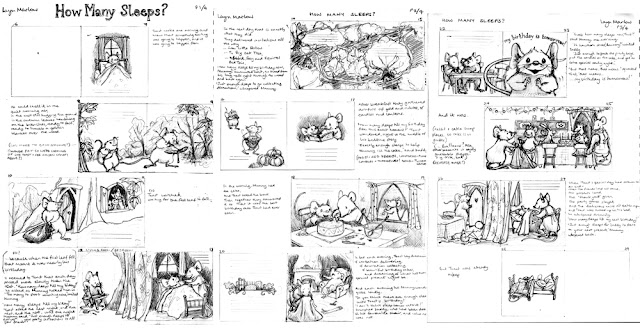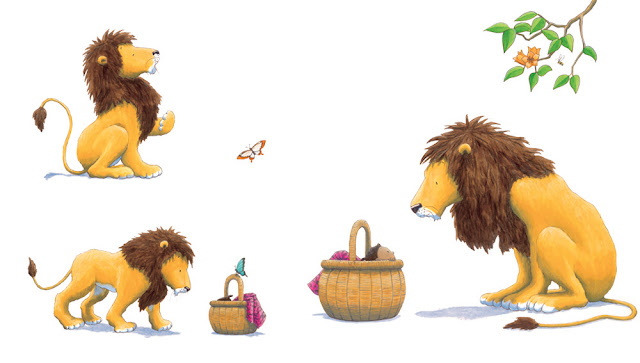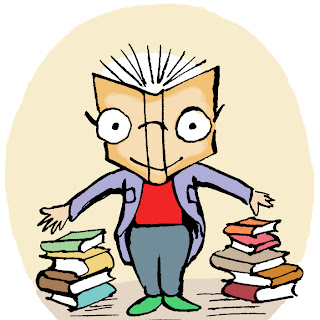 |
Layn and Rufus,
photo © Tom Greenwood
|
Layn Marlow i
s the new Featured Illustrator.
Check out her work on the Showcase site.
Layn talks about her background as an illustrator and how her style gradually evolved.
My first image is from
How Many Sleeps?, written by Amber Stewart, published by Oxford University Press in 2005, and again in 2011.
It was the first book I illustrated, but after I’d collaborated on five more with the same author using a different technique, OUP commissioned me to illustrate this new version, in keeping with the others.
 |
| Amber Stewart / Layn Marlow books for OUP |
Here’s the original version and, published the same year,
The Witch with a Twitch - my first as an author!
 |
How Many Sleeps? (OUP 2005),
author Amber Stewart, illustrations © Layn Marlow and
The Witch With a Twitch (Little Tiger Press 2005),
author Layn Marlow, illustrations © Joelle Dreidemy |
It was a joy to see Joelle Dreidemy’s amazing illustrations for my witch story – quite unlike anything I might have done myself. After so long hoping for publication, 2005 was a fantastic year, but my next goal would be publication for my own words and pictures
together. That took several more years though…
PATH TO PUBLICATION
Inspiration
As a child I lived next door to an elderly, childless couple, who possessed endless patience, a faithful dog and a fabulous garden backing onto fields, where I was allowed to play. My interest in nature stems from those early years.
 |
| Mr. and Mrs. P Mayes with Kim in their garden. Essex, c 1970 |
The only picture books I remember from that period were read on children’s television, but I soon learned to read the few books we had lying around at home. I especially loved Ernest Shepard’s illustrations of A A Milne’s poetry. Later I got hold of the
Pooh stories and bought all Michael Bond’s
Paddington books.
 |
| Books from my childhood |
I was always fascinated by words and pictures, which led to a degree in History of Art. I liked figurative art that served a purpose, whether narrative, like Early Renaissance altarpieces, or decorative, like the Arts and Crafts Movement.
 |
Golden Lily designed by John Henry Dearle
for William Morris & Co, 1899 |
(William Morris & Co clearly inspired the way I painted the end papers of those six Amber Stewart books, using details of flora and fauna I’d depicted in the stories. )
 |
End papers from I Love My Cloth (OUP, 2007)
author Amber Stewart, illustrations © Layn Marlow |
When I started working in libraries in 1989, I finally discovered and fell in love with picture books. Perhaps it was my own vivid memories of early childhood, which drew me to this combination of words and pictures, as a perfect way of communicating. I even found this helpful book to get me started!
 |
| How to Write and Illustrate Children’s Books and Get Them Published (Quarto Publishing 1988), Editors Treld Pelkey Bicknell and Felicity Trotman |
So, after some years living abroad with my husband and young children, I became a student again in 2001. With a first class degree in illustration under my belt, I felt more confident about approaching the world of publishing…but only slightly. Here’s how I did it:
I let the animals do the talking
 |
| Detail from Knock Knock Pig booklet © Layn Marlow |
I sent this small, sixteen-page booklet to about ten picture book editors. It showed that I could draw my little character in various attitudes throughout a narrative, and – bless his tiny trotters – he did the trick!
 |
| Layout of Knock Knock Pig booklet © Layn Marlow |
I secured meetings to show my portfolio to OUP, Little Tiger Press, and a couple of others, leading eventually to those first two published picture books in 2005.
How Many Sleeps? also brought an approach from my wonderful literary agent, Nancy Miles.
WORKING PROCESS
Nancy had liked these thumbnails for
How Many Sleeps? 2005. I always enjoy that early planning stage, before moving on to full-sized roughs.
 |
Thumbnails for How Many Sleeps? (OUP, 2005),
author Amber Stewart, illustrator © Layn Marlow. |
Then, alongside things like research for botanical accuracy, comes my favourite bit:
Character
I often start by drawing animals from life, then simplify form and add gesture to develop the character. I imagine how a character feels and sometimes act it out, to try to depict genuine emotion. I’ve gradually learned that less is more, and a small gesture might convey a character’s attitude better than an exaggerated facial expression.
 |
“I’m an extremely brave lion. I’ll ask it what it is.”
Spread from A Very Strange Creature (Orchard Books, 2009)
author Ronda Armitage, illustrations © Layn Marlow.
Shortlisted for the Red House Book Award 2010
Winner of Coventry Inspirations Book Award 2013 |
While this is happening, I’ll be considering what materials to use.
Technical issues
I used to
hate watercolour paper! I was constantly nervous about ruining it, so for my first eight books, I used acrylic paint on a smooth mountboard surface. The first
How Many Sleeps? was painted over a ground of thinned maroon paint, working from dark to light, using sepia brown pencils for outlines.
 |
“Toast woke early one morning.”
Sample for How Many Sleeps? (OUP, 2005)
author Amber Stewart, illustrations © Layn Marlow. |
For subsequent books my publisher suggested a gentler approach, so I worked from light to dark, applying thin layers of acrylic to the white or cream board, over outlines made using a dip pen and brown ink.
 |
“Bean was big enough to go dandelion picking”
Vignette from I Love My Cloth (OUP, 2007),
author Amber Stewart, illustrations © Layn Marlow |
This quieter, more naturalistic treatment of animal characters in a countryside setting, was more successful.
I Love My Cloth sold co-editions in over twenty countries, which must have helped OUP in their decision to publish
Hurry up and Slow Down in 2009. Here at last was a chance for me to illustrate my own text. Its central message about taking your time seemed apt!
 |
Hurry Up and Slow Down (OUP, 2009)
Text and illustrations © Layn Marlow.
Winner of Leespluim van der Maand, Netherlands, March 2009
; Winner of Coventry Inspirations Book Award UK, 2010;
Shortlisted for the Maine Chickadee Award, USA, 2011 |
Bug and Bear by Ann Bonwill (OUP, 2011), demanded a different approach. Brown kraftboard and chalky gouache seemed to suit a world, in which sleepy Bear thinks her ‘brown thoughts’.
 |
“Bear leaned against a tree thinking brown thoughts.”
Spread from Bug and Bear (OUP, 2011),
author Ann Bonwill, illustrations © Layn Marlow |
But my seventh collaboration with Amber Stewart was where I really conquered my technical ‘issues’.
Too Small for my Big Bed focuses on the relationship between a mother tiger and her cub. Dr. Ph.Martins inks on watercolour paper provided a vivid orange, to contrast with the deep ultramarine of the night sky. I overcame my fear of ruining the paper by printing parts of my drawing directly onto it, before soaking and stretching. I then felt liberated to use whatever medium I wanted to build the ‘scenery’: coloured pencil, watercolour, acrylic paint, and collage.
 |
“Piper was already fast asleep, spread out like a small star.”
Spread from Too Small for My Big Bed (OUP, 2013),
author Amber Stewart, illustrations © Layn Marlow |
I’ve used a similar approach, with a lighter palette, for
You Make Me Smile, to be published by OUP later this year. This will be the second book that I’ve both written and illustrated. And here’s evolution for you – my characters are now human beings!
 |
“Today is the special day”
Spread from You Make Me Smile (OUP, to be published October 2013)
Text and illustrations © Layn Marlow |
Discover what you’re good at and focus on doing it well. Then you can build on that core to tackle new challenges. This may sound obvious, but it can be hard to see your strengths and easy to get distracted. My trusted SCBWI critique group has been invaluable - and not only in helping me to move my own projects forward. It’s a privilege seeing other peoples’ work evolve, and in trying to help others, you begin to see what they respond to in you. It’s a great way of discovering where your own strengths lie.
Find out more about Layn on her website here
and on Facebook





























What a joy to read - thank you so much for sharing - I love your work!
ReplyDeleteWhat beautiful work! Images that will transcend time. These images are the sort my children loved with quirky details such as the cheese pattern on Toast's bed spread.
ReplyDeleteGorgeous, Layn! I can't wait for You Make Me Smile to be published.
ReplyDeleteFascinating to trace your process and how it's evolved Layn - thanks! And I love your thumbnails too. Can relate your old fear of ruining good paper so a technical question - do you print from your inkjet or laster printer onto watercolour paper?
ReplyDeleteThanks for sharing your journey, Layn. I love your work, especially your tigers and the gorgeous b&w hedgehog sketch on your portfolio.
ReplyDeleteThis is a terrific article Layn, well done! I loved reading of your journey and of your influences! The way you subtly convey character has a magical charm, combined with colours that give your work such warm resonance.
ReplyDeleteWhat a great story and inspiration. Beautiful work. I would love to know how Layn might approach a publisher nowadays with a book/illustration ready to go?!!
ReplyDeleteKeep up the good work :-)
Dennis - The short answer is that I'd never feel comfortable to say unilaterally that something is 'ready to go'!
DeleteIf you mean how would I personally approach a publisher now, it would be through my agent, as she's a good sounding board and knows when something is ready to show to an editor. (And 'ready' usually means a story that works, with appealing rough character drawings.)
If you mean, how would I approach a publisher now if I was starting out with a story and illustrations and no agent... I think it would still be similar to the way I did it originally. After I graduated, Fig Taylor of the AOI advised me that, even though I wanted to write and illustrate and already had a well-made dummy version of 'Hurry up and Slow down', I should offer myself up as "illustrator for hire" (her phrase). That way I'd show I'm interested in a career in picture books, and not just getting one thing published. This was good advice, because, as the article shows, illustrating other people's work taught me a lot, so the version of Hurry up and Slow down that was eventually published was very different from my original dummy. (You can compare 2 images in my showcase.)
Grabbing the attention of an editor or art director is probably still key though, and maybe there are more hi-tech ways to do that now, than with my little pig booklet. But as Bridget said in last month's FI article, "If you can show characters in different situations in a readable sequence, you’ll stand out". Once you have an editor's attention, they will be more open to seeing your dummies and story ideas and telling you if they're 'ready'!
Oops - I seem to have written a whole extra article! Hope I've managed to answer the question in there somewhere, Dennis.
Thanks for your comment and good luck with your work!
Many thanks for your comments, everyone! In answer to your technical question, Bridget - I just use an A3 Epson Inkjet printer. The ink can bleed slightly when I soak the paper, but for darker images, like the tigers it's not a problem once I then add colour. I needed to print lighter outlines for the snowman book though.
ReplyDeleteOh, that's excellent....
ReplyDeleteWhat a great way to approach a publisher. Thanks for sharing.
ReplyDeleteThis comment has been removed by the author.
ReplyDeleteWhat lovely illustrations! Thanks for sharing your story.
ReplyDeleteA wonderful article Layn and fascinating insight into your working methods and evolution of ideas. I enjoyed your SCBWI workshop a few years ago and hope that you run future ones too.
ReplyDeleteAbsolutely beautiful work! Must echo Paul's comment as I too really enjoyed that SCBWI workshop and hope you do more!
ReplyDeleteGosh, it just goes to show how much skill, craft and love goes into these illustrations. Thanks for this, Layn, it made my day.
ReplyDeleteLayn, thankyou for this really inspiring article. I have really enjoyed reading it.
ReplyDeleteI am about to buy a scanner /printer and I want one that will print on the watercolour paper I know some won't. Could you tell me which is the model you have that will do this? I have looked at an A3 Epsom but the man in the store wasn't sure whether it would work with the watercolour paper or not.
Thanks again for a great article.
Hi Heather - thanks for your lovely comments! My A3 printer is an Epson R2400, (as recommended to me by Anne-Marie Perks, who very kindly let me try hers out beforehand!). Unfortunately I bought mine second-hand, and it hadn't been used for ages, so I think it really needs servicing as it's going through ink at an alarming rate. The downsides are that it won't work if any of the 8 cartridges is empty, even if you don't need that colour, and the cartridges can be pretty expensive (about £25 each). But the good thing is that it has 3 different ways of loading paper, so with a bit of trial and error you can find the right setting for most types of thin card or paper. (As I said in answer to Bridget though, the ink isn't waterproof!)
DeleteGood luck with making your decision!
ReplyDeleteThankyou Layn for very helpful advice, I will have a look at this one today.
Thanks for sharing your story with us. I like your illustrations and the way you use body language with the animals. That's not something to take lightly. I think people who are interested in illustration as a career will learn a lot about presenting their work and studying to gain new skills by reading your own account. Thanks again.
ReplyDeleteChildren's book illustrators are special
ReplyDeleteNice Post, For Canon printer Toll Free Number 0800-098-8354, We provide you online help and support.Call us at Our Epson Printer Contact Number UK
ReplyDelete